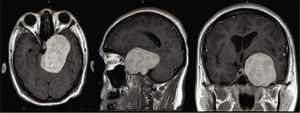Store:EMen02
Vestibular and trigeminal schwannoma
Secondary hemifacial spasm due to vestibular schwannoma is very rare. A study by S Peker et al.[1] was the first reported case of hemifacial spasm responsive to gamma knife radiosurgery in a patient with intracanalicular vestibular schwannoma. Both spasm resolution and tumor growth control were achieved with a single gamma knife radiosurgery session. Control of tumor growth was achieved and there was no change in tumor volume at the last follow-up at 22 months. The hemifacial spasm completely resolved after a year. It has been reported that surgical removal of the presumably causative mass lesion is the only treatment in secondary hemifacial spasm.
 Figure 1: Trigeminal scwannoma and dental maloccusion by Brandon Emilio Bertot et al.[2]
Figure 1: Trigeminal scwannoma and dental maloccusion by Brandon Emilio Bertot et al.[2]The criticism that can be made to this assertion is that in our case it is the masseter muscle is involved but this criticism is answered: If there is a hemifacial spasm from vestibular Scwannoma, could then a masticatory spasm from trigeminal Scwannoma occur? From a study by Ajay Agarwa [3] it appears that intracranial trigeminal schwannomas are rare tumors. Patients usually present with symptoms of trigeminal nerve dysfunction, the most common symptom being facial pain. MRI is the imaging modality of choice and is usually diagnostic in the appropriate clinical setting. T2-weighted 3D CISS axial sequences are important for a correct evaluation of the cisternal segment of the nerve. They are usually hypointense in T1, hyperintense in T2 with accretion after gadolinium. But we cannot be surprised if cases like the one described by Brandon Emilio Bertot et al.[2] in which a clinical case was reported of a 16-year-old boy with an atypical presentation of a large trigeminal schwannoma, dental malocclusion, painless and unilateral chewing weakness. The authors confirm that this case is the first documented case in which a trigeminal schwannoma has resulted in malocclusion; it is the 19th documented case of unilateral trigeminal motor neuropathy of any etiology.
- ↑ Peker S, Ozduman K, Kiliç T, Pamir MN, «Relief of hemifacial spasm after radiosurgery for intracanalicular vestibular schwannoma», in Minim Invasive Neurosurg, Georg Thieme Verlag, 2004, Stuttgart · New York».
DOI:10.1055/s-2004-818485 - ↑ 2.0 2.1 Brandon Emilio Bertot, Melissa Lo Presti, Katie Stormes, Jeffrey S Raskin, Andrew Jea, Daniel Chelius, Sandi Lam. Trigeminal schwannoma presenting with malocclusion: A case report and review of the literature.Surg Neurol Int. 2020 Aug 8;11:230. doi: 10.25259/SNI_482_2019.eCollection 2020.
- ↑ Ajay Agarwal. Intracranial trigeminal schwannoma Ajay Agarwal. Neuroradiol J.2015 Feb;28(1):36-41. doi: 10.15274/NRJ-2014-10117.